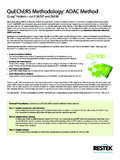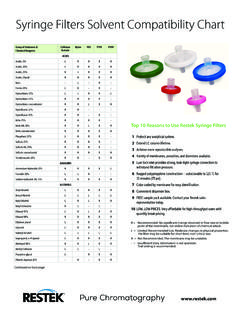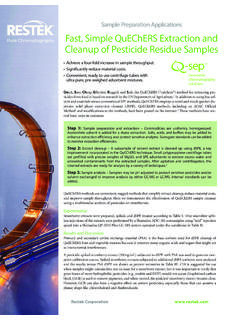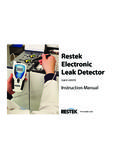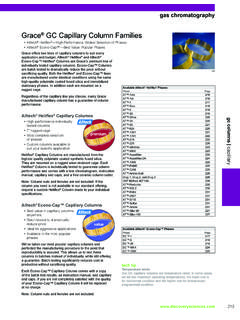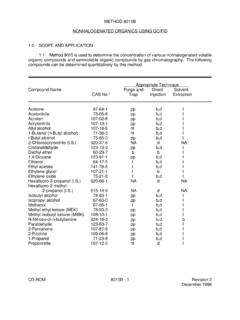Transcription of GC Columns Installation Guide - Restek
1 Innovative Chromatography GC Columns Installation GuideGC Column Installation Instructions pour l Installation d une colonne capillaireEinbau einer GC-Kapillars uleIstruzioni per l installazione di una colonna capillareInstalaci n de Columnas CapilaresGC The Restek Innovations and Technical Services specialists have found this to be a reliable sequence for avoiding problems when installing a capillary GC column. Instrument Preparation & Column Installation 1. Cool all heated zones. 2. Visually inspect indicating oxygen and moisture traps.
2 Replace saturated traps. 3. Examine the inlet and the detector. Clean or replace all dirty or corroded parts. 4. Replace the inlet liner, septum, and the injector seals (o-rings, inlet seals, ferrules, etc.). 5. Mount the column in the oven with a support that protects it from scratches. Center the column in the oven. This ensures uniform heat exposure generating consistent retention times. Note: Restek has two types of cages for fused silica Columns , an 11-pin cage and the original cage that uses high temperature string to hold the column in place.
3 If you have the cage with high temperature string, do not remove the string that holds the column in the cage! 6. Uncoil the ends to make sure the ends are long enough to reach the injector and detector. Cut a few centimeters from each end of the column. Note: To cut a fused silica column, use the smooth edge of a ceramic scoring wafer (cat.# 20116). 7. Slide the nut and appropriate size ferrule onto the inlet end of the column. Cut an additional 2 cm from the end of the column to remove any material scraped from the ferrule onto the edge of the column.
4 8. Install the column the appropriate distance in the injector, as indicated in your instrument manual. 9. Set the carrier gas to the flow rate or inlet pressure recommend-ed for the column or to your method flow rate/pressure. Confirm presence of column flow by immersing the column outlet in a vial of solvent and looking for bubbles. Warning: If you are using hydrogen as your carrier gas, you must safely vent the open end of your column out of the oven to prevent hydrogen buildup and minimize the potential for explosion.
5 10. Flush the column at ambient temperature with carrier gas: at least 5 minutes for a 25-30 m column and 10 minutes for a 50-60 m Set the injector temperatures. Do not exceed the column s maxi-mum operating temperature (listed on the column box). Check inlet for leaks using a Restek Electronic Leak Detector (cat.# 22839).12. Install the column into the detector as described in Steps 7 8. Set the detector gases and temperatures to proper Check the detector connections for leaks, using a Restek Electronic Leak Detector (cat.)
6 # 22839).14. Verify the carrier gas flow is at the rate you intend to use for your analysis. Set the split vent, septum purge, and any other applicable gas rates as Inject an unretained compound to verify the column is installed correctly and to determine the dead time. A symmetric peak indicates the column is installed correctly. Adjust the carrier gas flow as necessary to obtain proper dead Condition the column 20 C above the final analysis temperature of your method. Do not exceed the column s maximum operat-ing temperature.
7 For most applications, 1 hour of conditioning is sufficient. For sensitive detectors or low level analysis, longer conditioning times or conditioning the column at the maximum temperature may be beneficial. Extended time at high tempera-tures will not adversely affect column performance as long as precautions are taken to make sure the carrier gas is clean and is filtered for oxygen and To confirm proper column and system performance, analyze a column test mix for a new method or a known Your GC system is now ready to be calibrated and acquire.
8 For some types of sensitive detection systems, like MS, PID, and PDD, it is recommended to condition the column as listed in Step 16 without making the connection to the detector. In this case, plug off the detector during conditioning. After conditioning, continue with Step 12. Note: When you intend to condition thick-film coated Columns (film thick-ness > 1 m) at temperatures near the maximum operation temperature, it is recommended to do the initial 1-2 hours conditioning without a connec-tion to the detector and repeat procedure above, starting at Step 12.
9 Standby Conditions Short-Term: Leave the column in the GC with the carrier gas flow on at an oven temperature of 100-150 : Remove the column from the GC and seal the ends by gently and carefully pushing each end into the curved edge of a septum. Store the column in the original box away from strong you have any questions or problems installing a Restek column, visit or contact your Restek GC Column Installation Restek 1. 2. 3.
10 4. O- 5. Restek 11 6. cat.# 20116 7. 2cm 8. 9. 10.



